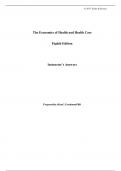© 2017 Taylor & Francis The Economics of Health and Health Care Eighth Edition Instructor’s Answers Prepared by Allen C. Goodman PhD © 2017 Taylor & Francis Chapter 1 Introduction 1. a. Three factors: Population size – large increases in population size will lead to increased expenditures, even if expenditures per person stay constant. Quantity per person – increases in quantity per person will lead to a larger aggregate , even if prices and population size stay constant. Price of health care – price increases can increase total expenditures, particularly if the demand is inelastic, that is , not responding to the increased prices. b. Similarities – most observers view housi ng, food, and health care as necessities for a suitable standard of living. Differences – health care is most often paid for by insurance, breaking the link between price and quantity. 2. As noted in the text, we look at (1) uncertainty; (2) prominence of insurance; (3) problems of information; (4) frequently large role of nonprofit firms; (5) restrictions on compet ition. These are present to some degree in other goods, but most other goods do not feature all of them in concer t. 3. From 1960 to 1980, Spain’s share increased from 1.5% to 5.3%, an increase of 253%, the largest percentage increase. Canada’s share increased from 5.4% to 7.0%, an increase of 30%, the smallest percentage increase. From 1980 to 2015, Korea’s share increased from 3.4% to 7.2%, an increase of 112%, the largest percentage increase. Ireland’s share (from 1980 to 2015) increased from 8.3% to 9.4%, an increase of 13%, the smallest percentage increase. 4. U.S. shares have grown by much larger proportions from 1960 to 2015 than the other tw o countries. In 1960 , the U .S. actually spen t a smaller share than Canada. Both the U .K. and Canada have more centralized control of the health economy than the U .S. 5. From 1980 to 2009, the CPI grew from 82.4 to 236.7 or by 187%. From 1980 to 2014, the Hos pital and Related Services index grew from 69.2 to 743.2 or by 974%. From 1980 to 2014 , the Physician Services index grew from 76.5 to 361.7 or by 373%. 6. From 1970 to 2014, Private Health Insurance grew by a multiple of 61.6; Medicare by 79.5; and Medicaid by 89.0. From 2000 to 2014, Private Health Insurance grew by a multiple of 2.1; Medicare by 2.7; and Medicaid by 2.4. 7. Students and their instructors should go to the appropriate websites. As of August 2017 these are: CMS – www.cms.gov NIH – www.nih.gov OECD – www.oecd.org Kaiser Family Foundation – www.kff.org © 2017 Taylor & Francis Chapter 2 Microeconomic Tools for Health Economics 2. An improvement in the technology of producing health would increase the health intercept. An increase in available productive resources would increase both intercepts (i.e. , the entire curve would shift outward). 3. Inefficiency will be shown by an interior point ( A) in a production -possibility diagram (Figure E2.1). Two efficient combinations are shown by B and C. The cost is the decrease in production of other goods (opportunity cost), moving from point B to point C. The amount of other goods given up is shown by BD. 4. a. Increase in supply leads to lower equilibrium price and higher equilibrium quantity. b. Same as (a). c. Decrease in demand leads to lower equilibrium price and lower equilibrium quantity. d. No effect on equilibrium price and quantity, but if the ceiling price is below the eq uilibrium price there will be excess demand. 5. a. This curve is linear. b. This curve is curvilinear. 6. The Food axis (horizontal) shows the maximum quantity of Food if all income is spent on food (i.e., none on health services). The reverse holds for the OG axis (vertical). The budget constraint will be unaffected if the income level and both prices double. 7. Elasticity is –1.5 × (300)/1050 = –0.43. The parameter –1.5 is the coefficient of the demand relationship. 8. This problem should refer to Table 2. 5. The slope is –17.2, i.e. , the reduction in the amount of capital. © 2017 Taylor & Francis 9. As noted in Figure E2.2, the equilibrium price does not rise by as much as the tax. A firm will move up the MR curve by the amount of the tax, but this does not lead to an equal price increase. With a linear demand, the slope (P/Q) of the MR curve is twice the numerical value of the slope of the demand curve. Thus , the price increase will be 50% of the tax. 10. Qd = 1815 – 10 ps Qd = 2115 – 10 ps 11. An $8 increase in price to $30 is a percentage increase of (from a $22 base) 36.4 %. Using the formula Elasticity = % change in quantity / % change in price , this would lead to a decrease in quantity of –0.7 multiplied by 36.4 percent or –25.5 perc ent. Using the midpoint of the interval, the percentage change in price is 30.8 % and the quantity decrease is 21.5 percent.




